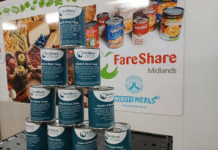On day two of the Drinktec trade show in Munich in Hall B4, KHS continues to show how its automated processes boost efficiency and reduce both the amount of operator intervention and the number of associated errors. The new, automated KHS InnoPET iflex line changeovers cut conversion times for an entire non-returnable PET line down to just 30 minutes.
With the number of SKUs constantly on the increase, this feature considerably boosts beverage producers’ degree of flexibility. The new stretch blow molder/labeler/filler block with its automated format changeovers illustrates how this can be combined with efficiency. With it, operators save precious time.
The example of KHS’ InnoPET TriBlock stretch blow molder/labeler/filler block illustrates how automated format changeovers can be successfully implemented. And it shows that beverage producers can combine maximum flexibility with high efficiency.

Photo: KHS
PET lines today are very rarely configured exclusively from individual machines. Instead, beverage producers want a turnkey system with a small footprint, shorter conveying segments, reduced maintenance effort, and – first and foremost – short changeover times. As part of the holistic, automated line changeovers on its PET lines, the InnoPET stretch blow molder, labeler and filler TriBlock satisfy these high demands. Thanks to the new KHS InnoPET iflex automation concept, beverage bottlers can now save up to 70% of the time needed for manual changeovers. To this end, various functions were developed for the different segments on the InnoPET TriBlock that considerably increase the level of automation and make manual intervention largely superfluous with a few clicks on the HMI.
Format changeovers by the robot
PET bottles are produced in the stretch blow molding module. When formats are scheduled for a changeover, the iflex first triggers the automatic loading of recipes for the heating profile, blow pressure, preform conveying and inspection technology.
This machine’s most important new feature is the mold changeover when the new batch requires a different bottle size or shape. Here, the switch is made with the help of a robot that changes the two side mold shells and base mold fully automatically and very quickly during ongoing production. It removes the previous molds from the stations, places them in the mold set magazine, takes out the new molds and slots them back into the stations without any need for action from the operator. For this short, fully reproducible procedure, the robot needs just 41 seconds per station. The time for manual intervention is thus reduced from a previous 95 to just eight minutes. This is further facilitated by automatic bottle base detection adjustment at the blow wheel transfer star with the help of several sensors. All the operator has to do by hand is to start the format changeover and later start the new production run.
Less manual intervention
The time and effort needed for manual work by the operator are also reduced in the labeling module. This is chiefly thanks to the automatic adaptation of the label gluing height and bottle diameter. However, the operator still carries out the toolless changeover of the vacuum drum, brushes and bottle guide parts. Nevertheless, two labeling stations can now be converted within 20 minutes.
At the press of a button
In the filler, module conversion is fully automatic. Firstly, this avoids handling errors by the operator, and secondly, it prevents the risk of bacterial or microbiological contamination by people entering the hygiene area that would then need foam cleaning. This would delay the changeover by around 30 minutes.
The key components relevant to automatic changeovers are the guides from the filler infeed to the capper discharge that need to be set to the bottle diameter and height. Conical base guides or bottle pockets are used here, for example, where the containers are fixed by simple height adjustment as in a funnel. The discharge conveyor is vertically adjusted by a servomotor instead of being manually cranked; the same goes for the horizontal adjustment of the railings. What’s more, the bottle caps are also changed over automatically, such as when a new beverage features a different cap color from the previous one.
Up to 70% quicker
We can see just how important the new iflex options are on the KHS InnoPET TriBlock in particular when it comes to highly flexible beverage filling if we take a look at the total time saving: depending on the specific changeover routine on-site, this amounts to approximately 95 minutes. The remaining manual tasks only take eight minutes on the stretch blow molding module and 20 minutes on the labeling module. On the filling module, format changeovers have been fully automated and are completed without intervention in a matter of seconds. All told, changeovers are now implemented in less than a third of the time previously required, allowing beverage producers to look forward to a high degree of flexibility and efficiency.
Innoline Flex Control – Everything is under control
The Innoline Flex Control line management system is essential if the iflex is to function properly and its potential be fully exploited. It takes over the tasks of line and order management from the beverage producer’s ERP system and orchestrates the automatic changeover of the machines. The basic idea is to help the operator always do exactly the right thing.
Integrating the Innoline Flex Control web GUI into the HMI displays data on the machine operator panel. The operator sees which processing program must be selected when and which materials are needed where to produce the respective current version of the order sequence that has been tactically planned by the system. With the automated iflex variant, this is triggered by the simple press of a button. On the guided iflex version, the system clearly prompts the operator through the various steps and provides straightforward instructions for all action that needs to be taken manually.
IndiFoodBev — authentic, impactful and influential
An English-language food and beverage processing and packaging industry B2B platform in print and web, IndiFoodBev is in its third year of publication. It is said that the Indian food and beverage industries represent approximately US$ 900 billion in revenues which implies more than 20% of the country’s GDP. Eliminating the wastage on the farmside can help to deliver more protein to a higher number of the population apart from generating sizable exports. The savings in soil, seeds, water, fertilizer, energy and ultimately food and nutrition could be the most immense contribution that country is poised to make to the moderation of climate change.
To improve your marketing and grow sales to the food and beverage processing and packaging industry, talk to us. Our research and consulting company IppStar [www.ippstar.org] can assess your potential and addressable markets in light of the competition. We can discuss marketing, communication, and sales strategies for market entry and growth.
Suppliers and service providers with a strategy and budget for targeted marketing can discuss using our hybrid print, web, video, and social media channels to create brand recognition linked to market relevance. Our technical writers are ready to meet you and your customers for content.
The second largest producer of fruit and vegetables in the world is continuously expanding processing capacities and delivery systems with appropriate innovative technologies. We cover product and consumer trends, nutrition, processing, research, equipment and packaging from farm to thali. Get our 2025 media kit and recalibrate your role in this dynamic market. Enhance your visibility and relevance to existing markets and turn potential customers into conversations. Ask for a sample copy of our bi-monthly in print or our weekly IndiFoodBev eZine each Wednesday.
For editorial info@ippgroup.in — for advertisement ads1@ippgroup.in and for subscriptions subscription@ippgroup.in
Naresh Khanna – 10 February 2025
Subscribe Now











